Scanning Around With Gene: Double Your Pleasure, Double Your Fun
The announcement last week that the Wrigley Company would merge with candy-maker Mars in a deal worth $23 billion took me by surprise. Not because it represents one of the largest mergers in recent times, but because the dollar value indicates that there are a lot more gum chewers in the world than I ever imagined. While it’s true that Wrigley sells more than just gum (Lifesavers and Altoids, for example), the bulk of the company’s $4 billion yearly revenue still comes from brands like Doublemint, Juicy Fruit, Orbit, and Eclipse.
Aside from a brief period of bubble-gum obsession as a youth, I’ve never been much of a gum chewer. But it seems the world is broken down into people who chew gum and those who don’t. Once hooked, gum is a pretty regular habit, and many people use it as a way to avoid other habits and addictions. If you go to the Wrigley Web site you’ll discover many supposed benefits to chewing gum, including stress relief, memory improvement and good oral hygiene.


In fact, Wrigley’s and many other gums have been sold as being good for the teeth and for digestion since the beginning. It seems that people have wanted to chew on things for a very long time: The predecessors to modern chewing gums go back to ancient Greece. And long before William Wrigley Jr. founded his chewing gum company in Chicago in 1891, several others were selling gum in America, including Thomas Adams, who patented one of the first machines for manufacturing chewing gum.
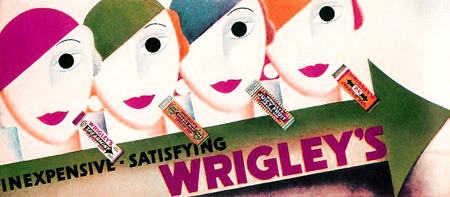

But it was Wrigley, shown here with a picture of the 1929 Chicago Cubs baseball team and famous Wrigley Field in Chicago, who combined just the right flavors, marketing, and distribution to turn gum into a global phenomenon. His first brand was Juicy Fruit, followed by Spearmint.



In 1914 Wrigley used a “double distillation process” to produce a new brand, Doublemint. It became one of the most popular gums in the world and in 1939 the Wrigley company introduced the famous Doublemint Twins, drawn by Wrigley art director Otis Shepard. The use of airbrush techniques gave the original Doublemint Twin images a unique and distinctive look.


Wrigley used billboards very effectively and always portrayed chewing gum as a fun, lively experience. Here are a number of display cards used in trains and trolley cars.


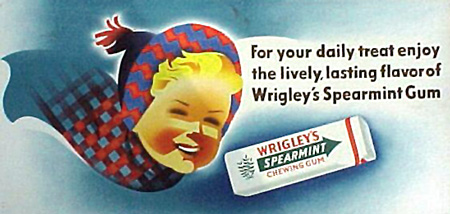

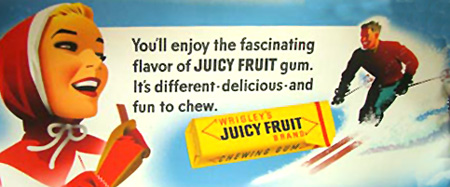

Because gum was relatively cheap, it became one of the early “point-of-purchase” (POP) retail items, often displayed at checkout counters. Wrigley used point-of-purchase displays very effectively and even suggested that people “take their change in gum.” The following images of POP items are from the Jerry Rudy and John Reech collections, recently auctioned on eBay.

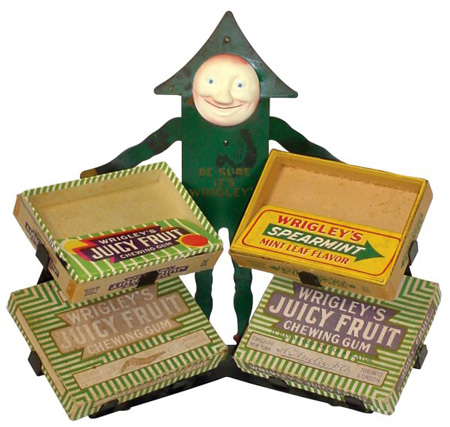


Wrigley’s also used character advertising extensively, as shown in these ads featuring the Wrigley “mint guys.” I wasn’t able to determine whether these characters had names, but they appeared in ads throughout the early history of the company.


During World War II, a shortage of ingredients led Wrigley to take Spearmint, Juicy Fruit, and Doublemint off the civilian market, and all gum production was given over to serving the armed forces. In 1946 these brands were re-introduced to the civilian market with great fanfare. Here is a drawing of a famous Wrigley neon sign in New York’s Times Square.
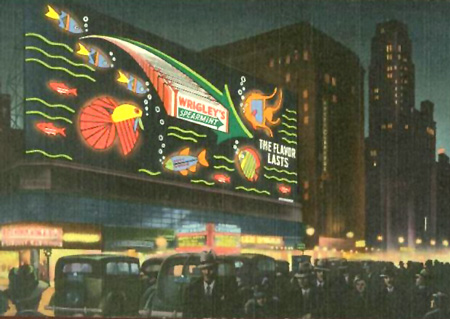
Another Wrigley milestone occurred in 1974 when Juicy Fruit gum became the first product to use a new technology called the “universal product code,” or UPC. At a supermarket in Troy, Ohio, on June 26, a 10-pack of Juicy Fruit was run through a hand-made laser scanner and the register automatically ran up the sale at 67 cents.
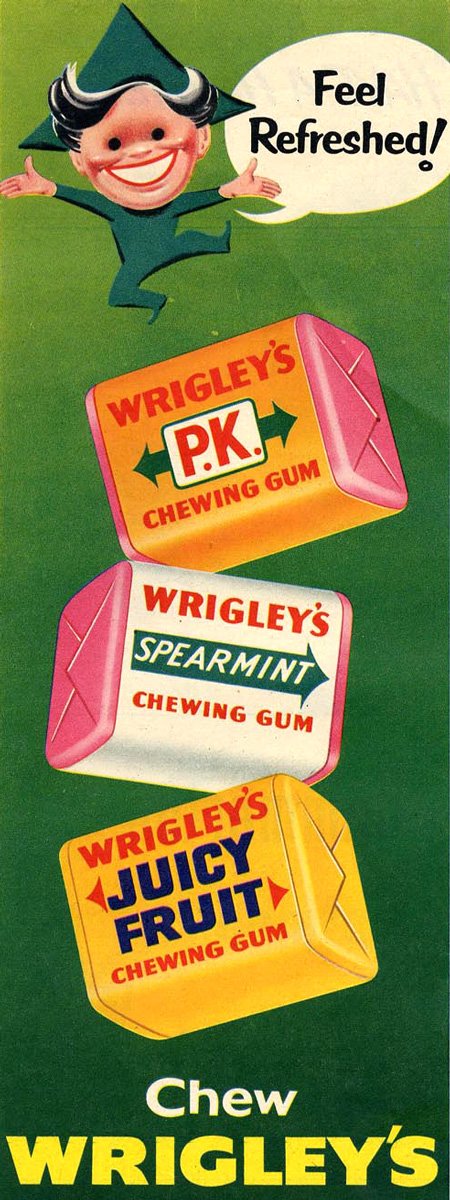
The Wrigley Company is still run by a descendant of William Wrigley Jr., and the Wrigley building in Chicago is a recognizable landmark. Now, as a division of Mars, Wrigley becomes part of a mega-candy empire that includes Snickers, M&Ms, Skittles, and several lines of popular pet food.


Most gum is no longer made from natural tree sap (as early gum was), and you may want to check with your dentist before you consider chewing gum as part of your oral hygiene regimen. But if you’re a gum chewer, you may be looking forward to a time in the not-too-distant future where your choices not only include Juicy Fruit and Doublemint, but 3 Musketeers Gum, Snickers Gum, Twix Gum, and perhaps even Pedigree Gum for your pets.

